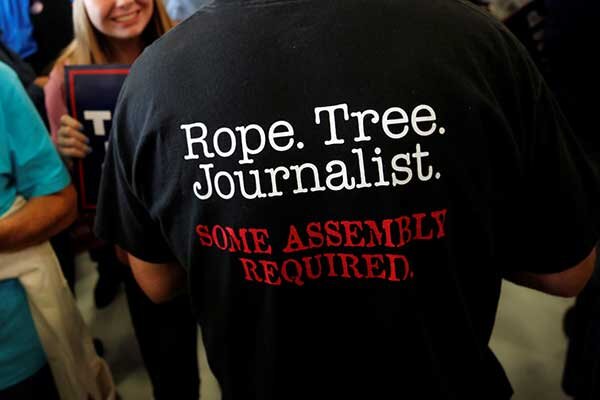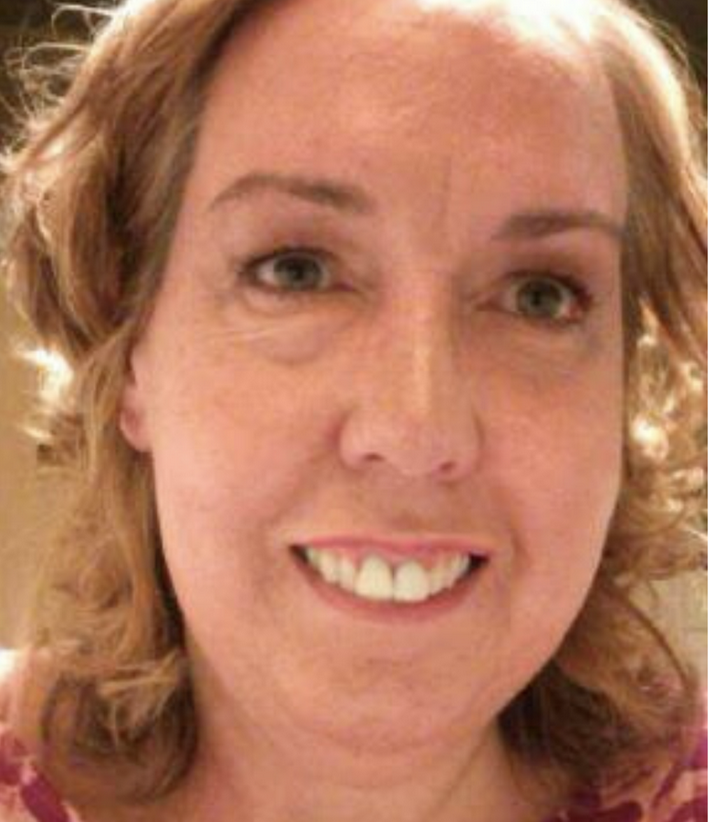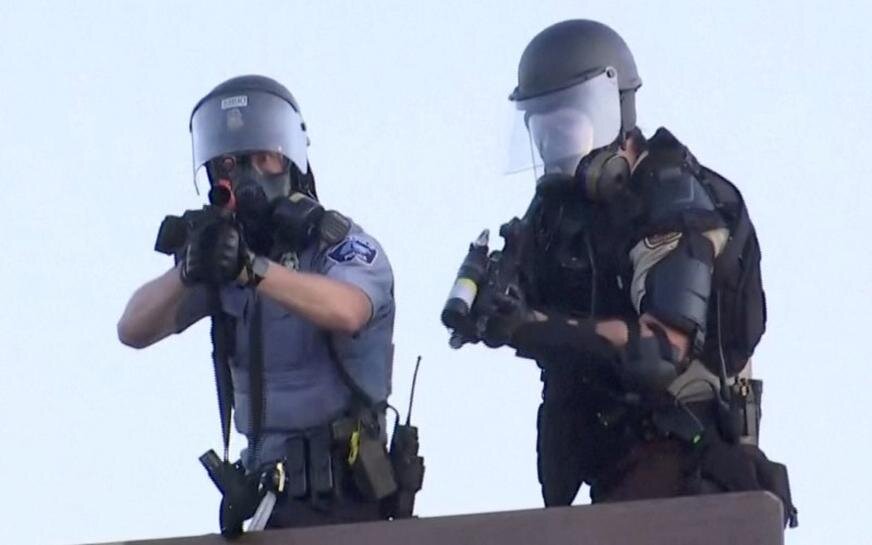Targeting Journalists
A T-shirt favored by anti-media extremists. Photo courtesy of Committee to Protect Journalists.
AFTER YEARS OF VERBAL ASSAULTS ON LATINOS AND ON THE MEDIA BY POLITICIANS AND IDEOLOGUES, A SUMMER OF PROTEST YIELDS NEW DANGER FOR JOURNALISTS OF COLOR
Editor’s note: The Committee to Protect Journalists recently called out the intentional targeting of journalists: “All law enforcement agencies must stop using aggressive tactics against journalists covering protests in the United States,” said CPJ Program Director Carlos Martínez de la Serna, singling out a federal officer’s shooting of a photographer with a “non-lethal” pellet in a Portland protest. It was not the first law enforcement strike against a journalist this summer, here in the United States, not in some far-off authoritarian nation. On palabra., we’ve documented harassment of border reporters after a racist mass shooting of Latinos in El Paso. And we chronicled important work being done to protect the mental health of journalists covering so much crisis in 2020. Here, we take a comprehensive look at how the state of play for journalists in the United States includes an unprecedented threat of violence.
By Patricia Guadalupe
Julio César Chávez had barely unpacked after moving from El Paso to Washington, D.C., to work as a video producer for the Reuters news service when he was suddenly on a plane again, dispatched to cover the protests and demonstrations in Minneapolis, Minnesota, in the aftermath of George Floyd’s death.
The law enforcement officers involved in Floyd’s death worked out of a Minneapolis Police Department precinct where protests had been intensifying.
It was there that Chávez saw something he had never witnessed as a reporter: police -- on U.S. soil and without explanation -- aiming weapons directly at him and the Reuters security guard. Both were wearing press credentials; the security guard, Rodney Seward, wore a vest that said “PRESS” in big white letters, visible even at night.
“I bent down to adjust my gas mask. I had my back to them and that’s when I got hit with a rubber bullet on my left arm and the back of my neck, and my security advisor got shot in the face. I was deliberately aimed at by a police officer,” Chávez said. The pair ran to shelter at a nearby gas station.
As in many of the protests against police brutality and racial inequity that dominated streets in cities across the nation this summer, a frightening rise in aggression against journalists of color set off alarm bells among groups that work to protect reporters. They note that attacks on journalists are no longer something that only foreign correspondents and international media need to worry about.
This summer, assaults and threats to reporters from Portland, Oregon, to Washington, D.C., have become frightening, but almost routine, scenes on television and the covers of digital news outlets.
Everyone has gotten close-up views of actions against journalists.
From Minneapolis, Chavez live-streamed his brush with police brutality to the Reuters Washington bureau.
He even recorded an officer pointing his firearm at the journalists. “I’ve had hostile environment training before and I’m not surprised because we are trained to expect anything and everything, but something like that has never happened to me.”
Law enforcement officers took aim at a Reuters News Service crew during the Minneapolis uprising after the George Floyd killing. Photo courtesy of Julio César Chávez.
Long-term damage
Chávez and Seward have since fully recovered, but the effects will linger far longer.
In Los Angeles, Aaron Cantú anticipates similar, lingering pain.
Cantú was with another reporter, covering a protest, when he saw a crowd running toward them ahead of a large contingent from the Los Angeles Police Department dressed in riot gear.
“We ended up sandwiched in between two lines of police and even though we were telling them, insisting, we were press, they ignored us,” the Los Angeles-based freelancer told palabra. “They grabbed me and shoved me into a chain-link fence and said I was arrested because we were out after the curfew, even though it wasn’t after the curfew and the curfew doesn’t even apply to the press. They cuffed me with zip ties.”
Cantú said his reporting partner eventually convinced police that they were indeed working journalists.
“They took the zip ties off and one of the officers said we needed to go home because the curfew applied to everyone and I said no, it doesn’t,” Cantú recalled. “One of the other officers agreed and let us go, but not before taking down all our information.”
Cantú, who has covered numerous street protests in his career, said he was cuffed for about 20 minutes. “At that point, I just went back home. They were very aggressive. I don’t understand why they were arresting anyone when it wasn’t even the curfew.”
For Cantú, it was not an isolated incident.
“I was also arrested covering the Trump inauguration in 2017 and I went through a lot of legal battles for about a year and a half,” he said. “I feel I have some PTSD about massive arrests and being trapped by the police. When I got arrested in L.A., I wasn’t just concerned about what might happen, but it also brought back a lot of traumatic memories for me.”
Stark evidence of police targeting Reuters journalist Julio César Chávez during the Minneapolis unrest this summer. Photo courtesy of Julio César Chávez.
Working without a safety net
Cantú says this latest confrontation with law enforcement convinced him to avoid street protests and coverage of volatile situations without press credentials from one of his outlets.
Working without fear of intimidation or arrest is especially difficult for freelancers like Cantú, professionals who are a growing segment of today’s journalism.
Former NAHJ board member Rebecca Aguilar, a Dallas-based freelancer, suggests going into action prepared, carrying something as simple as a reporter’s notebook, or sophisticated as a bookmarked LinkedIn profile, ready to show to any inquiring authority. “Or say Google my name,” Aguilar added. “Anyone can show up with a phone and say they are a journalist -- and there are wannabe reporters out there. The more information you can give them, the better. And be firm.”
Aguilar’s business card looks like a mini-résumé -- it even features links to her work. She’s also on the board of the Society of Professional Journalists, which is considering issuing press identification for freelancers who don’t have the kind of credentials usually reserved for news outlet staffers.
The growing ranks of journalists who’ve been physically attacked or threatened while on the job in the United States has accelerated talk about safety.
Luis Sinco, a photojournalist with the Los Angeles Times, considers himself lucky because it was “only” his camera that got hit with a rubber bullet while he covered a recent protest.
“I’ve been to Iraq, I was in Libya during their revolution, so I don’t really freak out anymore, but the L.A . police were firing indiscriminately,” Sinco said.
He remembers getting it “from all sides” when he went to photograph looting during a protest. “They were menacing us, telling us not to take photos, and then I got trolled on social media by people saying why did you put my photo up?”
Freelance journalist Aaron Cantú ended up handcuffed and arrested during a police brutality protest in Los Angeles. Photo courtesy of Aaron Cantú.
A new domestic threat
Attacks and intimidation are nothing new for journalists in other countries. Until recently it was rare in the United States, says Dagmar Thiel, a USA director at Fundamedios, which promotes press freedom and press protection throughout the Americas. Founded in Ecuador, Fundamedios expanded into the United States two years ago and has been closely monitoring incidents like those that Chávez, Cantú, Sinco and others recently lived through. Today she is conducting a nationwide survey on working conditions for Latino/a journalists.
Attacks have “happened here as a result of the anti-press attitude promoted from the top at the White House,” Thiel said. “While many others such as governors and mayors have condemned these attacks, it still is something to consider that they have happened in the first place.”
In a statement, Thiel said it’s political leaders who must “promote calm and dialogue in order to prevent an increase in attacks against residents and the press and to guarantee democracy.”
The U.S. Press Freedom Tracker, a coalition of journalism groups – including NAHJ – has reported a rise in attacks against journalists in the United States. Reporters Without Borders recently said “press freedom in the United States continues to suffer” and ranks the U.S. as “problematic” for journalists. This was in a report published before this summer’s attacks against journalists.
Probably the most blatant incident was the May 29 arrest, during a live broadcast, of CNN journalist Omar Jiménez and his camera crew, including photojournalist Leonel Méndez. CNN still disputes the police’s initial account that they were released once the police established that they were journalists. It was clear in the live broadcast that Jiménez and his colleagues had their press credentials visible and repeatedly identified themselves as working for CNN.
US Park Police shove a cameraman for 7News Australia during a police brutality protest in front of the White House last month. Photo courtesy of ABC7 WJLA.
Anti-media Tweets from the White House
The Committee to Protect Journalists last year found that more than 11 percent of tweets from President Trump insulted or criticized journalists and media organizations. Amid recent street strife and coverage of protests, like the one violently disrupted by police so the president could stage a photo in front of a damaged church, his scorn for journalists has increased.
A crew from the Telemundo network was among the several journalists roughed up in that melee, in the park across the street from the White House.
At that same time, closer to the White House, a television crew from Australia’s Seven News was broadcasting live when U.S. Park Police, in riot gear, struck them with batons and pushed them with their shields. Correspondent Amelia Brace was hit on her legs and back with rubber bullets as the crew rushed away. The incident drew widespread condemnation, including from the Australian ambassador to the United States. Police actions that night are now under a congressional investigation. The officers seen striking the crew have been suspended, and at a House Natural Resources Committee hearing, Brace told lawmakers the attack on her crew was unlawful.
---
“It is crucial to democracy that journalists be allowed to do their job freely and safely, and that is certainly something we should expect in the world’s greatest democracy,” Brace told the committee. “As a reporter I have no interest in becoming the story but recently many of us have been left with no choice. I am shocked to see how many journalists have been attacked, beaten, and detained just for doing their jobs.”
Patricia Guadalupe is a bilingual multimedia journalist based in Washington, D.C., and president of the NAHJ DC Chapter. She has long covered politics, business and culture in the capital for both English and Spanish-language media outlets. She was previously a reporter in New York City. She’s been an editor at Hispanic Link News Service (where she still writes political news), a reporter at WTOP Radio (CBS Washington affiliate), a contributing reporter for CBS Radio network, and has written for NBC News.com and Latino Magazine, among others. She is a graduate of Michigan State University and the Graduate School of Political Management at George Washington University.







